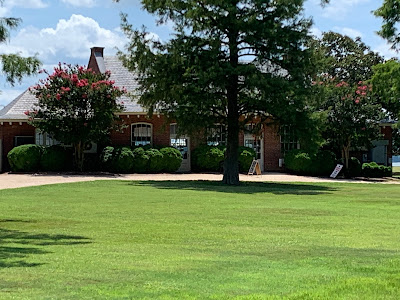There are two different areas to visit in Jamestown. Our first stop was the Jamestown Settlement.
The Jamestown Settlement is a living history museum operated by the Commonwealth of Virginia and was created in 1957. It includes a recreation of the original James Fort (c. 1607-1614), a Powhatan Native American town, indoor and outdoor displays, and replicas of the original settlers' ships. Since it was hot and getting hotter, we decided to visit the outdoor displays first.
In December, 1606, Susan Constant, Godspeed, and Discovery left England with 105 colonists and supplies of food, tools, and military equipment to start a new colony in Virginia. The English investors who funded the colony hoped to tap into Virginia's valuable resources, encourage new industries, and find a route to the riches of the East Indies.
There were some nice replicas of the ships.
Susan Constant
Chapel
Since it was now getting hotter, it was time to go in to view the movie and visit the museum.
We learned a bit about Pocohontas. She was born c. 1596 as Amonute and known as Matoaka. She was the daughter of Powhatan, the paramount chief of the network of tributary tribes in the area encompassing the Tidewater region of Virginia.
In 1613, Pocahontas was captured and held for ransom by English colonists during hostilities. During her captivity, she was encouraged to convert to Christianity and was baptized under the name Rebecca. She married tobacco planter John Rolfe in April, 1614 at the age of about 17 or 18, and she bore their son, Thomas Rolfe, in January, 1615.
In 1616, the Rolfes travelled to London where Pocahontas was presented to English society as an example of the "civilized savage" in hopes of stimulating investment in the Jamestown settlement. She became something of a celebrity and was elegantly feted. Pocahontas died at Gravesend, England of unknown causes when she was 20 or 21. She was buried in St. George's Church in Gravesend, however her grave's exact location is unknown because the church was rebuilt after being destroyed by a fire.
Pocahontas is most famously linked to colonist Captain John Smith, who arrived at Jamestown in April, 1607. In December, 1607 Smith was captured by Powhatan's close relative and in his 1608 account, he describes a great feast followed by a long talk with Powhatan. He does not mention Pocahontas in relation to his capture and claims that they first met some months later. The stories about the relationship between John Smith and Pocahontas seem to be exaggerated.
Captain John Smith, who sailed on the initial voyage from England to Virginia in 1606-1607, was badly injured by a gun powder explosion sometime in 1609. He returned to England for treatment in October of the same year and never set foot in Virginia again.
John Smith
Thankfully, Wendy had clued us in that there are actually two areas of Jamestown and since no one at the settlement told us about it, we would have missed the Jamestowne Rediscovery project. Jamestowne Rediscovery is an archaeological project investigating the remains of the original English settlement at Jamestown beginning on May 14, 1607.
In 1994, archaeologist William Kelso began directing excavations at Jamestown Island. By 1996, the Jamestown Rediscovery team had discovered the foundations of the 1607 James Fort, long thought to have disappeared in the waters of the James River. It was initially a 10-year project, but given the wealth of knowledge and artifacts uncovered throughout its lifetime, it has been continued indefinitely. And it is fascinating!
A beautiful monument greeted us as we walked onto the island.
And then there was the churchyard adjoining the church. Walking through it was interesting.
When the Association for the Preservation of Virginia Antiquities (now Preservation Virginia) acquired 22.5 acres of Jamestown Island in 1893, they acquired the 17th century church tower site. Archaeology around the old church foundations was conducted and there was a plan for the construction of a new church to celebrate the 300th anniversary of the settlement in 1907.
The new Memorial Church was modeled after St. Luke's Church in Smithfield and used bricks from two old buildings in Hampton, Virginia. Glass panels in the floor allows visitors to see the brick foundations of the 17th-century churches, including the one in which the colonists met in 1619 for the first representative assembly in English North America. The Memorial Church is adjacent to, but not directly connected to, the 17th-century tower. It was officially dedicated on May 13, 1908.
In 2019, the Memorial Church reopened after being closed for two years for excavations within the building. During that time, archaeologists re-examined the foundations of the 17th-century churches that once stood on the site. Following completion of the digging, a new floor and wooden framing reflecting the footprint and structure of the 1617 church were installed.
Church Tower
Inside the church we saw this.
Boy, it was blazing hot by now and we were negligent in not bringing water with us. It was a long walk back to the visitor's center so we thought about whether we should go back or just persevere. And then like an oasis......
After a nice break, we forged on and saw this foundation. This is the original foundation of the first purpose-built statehouse at Jamestown. From the very beginning the efforts at Jamestown were influenced by the laws and legal institutions of England.
We weren't sure what to expect here but we went inside (it was air conditioned!).
The number of artifacts on display was overwhelming. The guide told us that we could take photos except the room where the skeletons were held. That exhibit, while it seemed morbid, captured our attention for quite awhile. The details they are able to gain from the skeletons was incredible.
There was a time capsule.
And with that we were back at the truck. We're moving on tomorrow - thanks for the history lessons, Virginia!































No comments:
Post a Comment